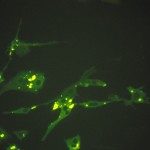Link to Pubmed [PMID] – 10073697
J. Gen. Virol. 1999 Feb;80 ( Pt 2):371-9
Dobrava hantavirus (DOB) was isolated from the striped field mouse (Apodemus agrarius) trapped on Saaremaa Island, Estonia, and its genetic and antigenic characteristics were subsequently analysed. Phylogenetic analysis showed that the Estonian DOB strain, together with several wild strains carried by Apodemus agrarius, forms a well-supported lineage within the DOB clade. The topography of the trees calculated for the S, M and L nucleotide sequences of the Estonian DOB suggests a similar evolutionary history for all three genes of this virus and, therefore, the absence of heterologous reassortment in its evolution. A cross-neutralization comparison of the Estonian virus with the prototype DOB, isolated from a yellow-necked mouse (A. flavicollis) in Slovenia, revealed 2- to 4-fold differences in the end-point titres of rabbit and human antisera. When studied with a panel of 25 monoclonal antibodies (MAbs), the Estonian and Slovenian DOB isolates showed similar antigenic patterns that could be distinguished by two MAbs. Genetic comparison showed sequence differences in all three genome segments of the two DOB isolates, including an additional N-glycosylation site in the deduced sequence of the G2 protein from the Estonian virus. Whether any of these mutations relates to the different rodent hosts rather than to the distant geographical origin of the two isolates remains to be resolved. Taken together, our observations suggest that A. agrarius, which is known to harbour Hantaan virus in Asia, carries another hantavirus, DOB, in north-east Europe.

